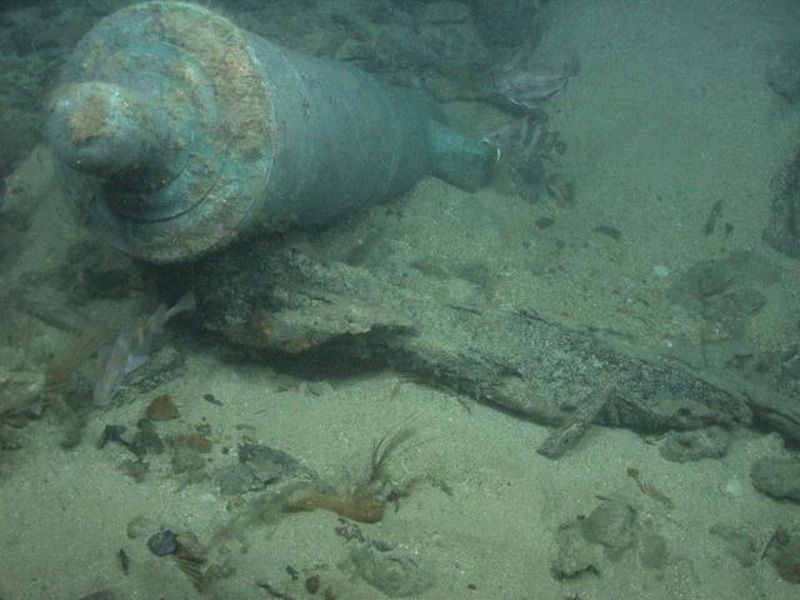
A British warship that sank off the coast of England 270 years ago may soon reveal its secrets.
The U.K. Secretary of State for Defense has given the go-ahead to Odyssey Marine Exploration, Inc., a deep-ocean exploration company based in Tampa, Florida, to mine the HMS Victory for archaeological artifacts at risk of being damaged.
"We are looking forward to sharing the progress of this exciting archaeological project and the stories told by the recovered artifacts with the public," Lord Lingfield, chairman of the Maritime Heritage Foundation, said in a statement. (The Maritime Heritage Foundation is spearheading the efforts to study and preserve archaeological artifacts from the site.) "HMS Victory is the only wreck of a first-rate English warship discovered underwater anywhere in the world." [See Images of the HMS Victory Shipwreck]
Among the ship's treasures are dozens of bronze cannons emblazoned with the seals of King George I and King George II.
Premier warship
The HMS Victory was the premier ship in the U.K.'s flagship fleet when it first set sail in 1737. But just nine years later, on Oct. 5, 1744, the ship and all its crew were lost. After winning a skirmish against the French, Admiral John Balchin was navigating the ship through the English Channel when the Victory hit stormy seas. The HMS Victory was separated from the other 16 warships in her fleet, and though those ships eventually made it to port, damaged but intact, the Victory never reappeared, according to the website victory1744.org.
At the time, people in Alderney, the northernmost Channel Island, reported hearing shots fired from a ship, and witnessed flotsam drift ashore at various islands in the chain. People have long suspected that the ship capsized not far from Alderney.
Sign up for the Live Science daily newsletter now
Get the world’s most fascinating discoveries delivered straight to your inbox.
The Victory's top-heavy weight distribution from its many guns, as well as rotting timbers and a shoddy design, could have doomed the ship to capsize, according to victory1744.org. For more than two centuries, historians believed that the ship had been ripped apart on the rocky islets of The Casquets, an underwater sandstone ridge in the English Channel known for rough waters.
Wreck discovery
In 2008, Odyssey Marine Exploration deployed a remotely operated underwater vehicle named Zeus in the general region thought to harbor the ship's wreckage. That survey revealed wooden planks, iron ballasts, anchors and 41 bronze cannons at a site about 60 miles (100 kilometers) from its supposed resting place.
Among the shipwreck treasures are two bronze cannons, one emblazoned with King George I's crest, and another with King George II's seal. Both have the mark of the maker ("SCHALCH"), from Andrew Schalch, who operated the Royal Brass Foundry. The cannons also have distinctive dolphin handles that were characteristic of weaponry from the time period, according to Odyssey Marine Exploration officials.
The last 270 years have not been kind to the HMS Victory. The nooks and crannies at the site are teeming with octopuses, fish and crabs, making it an attractive place for fishermen to trawl. But the boats dredging the seafloor have also disturbed the site of the shipwreck. Since its discovery in 2008, a massive cannon has been upended, and in subsequent expeditions, glass bottles, lobster traps and even video cassette tapes have been found, according to a 2009 research team that surveyed the site.
The new approval from the U.K. Ministry of Defense will allow Odyssey Marine Exploration to harvest some archaeological artifacts that may be most at risk of being damaged if they remain on the seafloor.
Follow Tia Ghose on Twitter and Google+. Follow LiveScience @livescience, Facebook & Google+. Originally published on Live Science.

Tia is the managing editor and was previously a senior writer for Live Science. Her work has appeared in Scientific American, Wired.com and other outlets. She holds a master's degree in bioengineering from the University of Washington, a graduate certificate in science writing from UC Santa Cruz and a bachelor's degree in mechanical engineering from the University of Texas at Austin. Tia was part of a team at the Milwaukee Journal Sentinel that published the Empty Cradles series on preterm births, which won multiple awards, including the 2012 Casey Medal for Meritorious Journalism.










